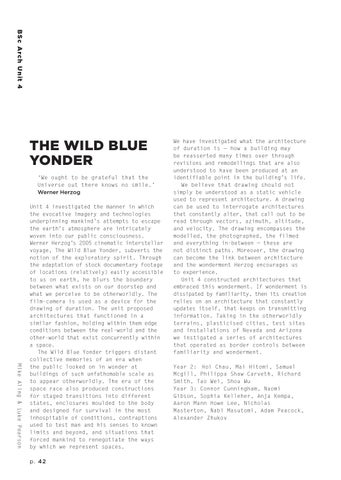BS c A rc h U ni t 4
THE WILD BLUE YONDER ‘We ought to be grateful that the Universe out there knows no smile.’ Werner Herzog
Mike Aling & Luke Pearson
Unit 4 investigated the manner in which the evocative imagery and technologies underpinning mankind’s attempts to escape the earth’s atmosphere are intricately woven into our public consciousness. Werner Herzog’s 2005 cinematic interstellar voyage, The Wild Blue Yonder, subverts the notion of the exploratory spirit. Through the adaptation of stock documentary footage of locations (relatively) easily accessible to us on earth, he blurs the boundary between what exists on our doorstep and what we perceive to be otherworldly. The film-camera is used as a device for the drawing of duration. The unit proposed architectures that functioned in a similar fashion, holding within them edge conditions between the real-world and the other-world that exist concurrently within a space. The Wild Blue Yonder triggers distant collective memories of an era when the public looked on in wonder at buildings of such unfathomable scale as to appear otherworldly. The era of the space race also produced constructions for staged transitions into different states, enclosures moulded to the body and designed for survival in the most inhospitable of conditions, contraptions used to test man and his senses to known limits and beyond, and situations that forced mankind to renegotiate the ways by which we represent spaces. p. 4 2
We have investigated what the architecture of duration is — how a building may be reasserted many times over through revisions and remodellings that are also understood to have been produced at an identifiable point in the building’s life. We believe that drawing should not simply be understood as a static vehicle used to represent architecture. A drawing can be used to interrogate architectures that constantly alter, that call out to be read through vectors, azimuth, altitude, and velocity. The drawing encompasses the modelled, the photographed, the filmed and everything in-between — these are not distinct paths. Moreover, the drawing can become the link between architecture and the wonderment Herzog encourages us to experience. Unit 4 constructed architectures that embraced this wonderment. If wonderment is dissipated by familiarity, then its creation relies on an architecture that constantly updates itself, that keeps on transmitting information. Taking in the otherworldly terrains, plasticised cities, test sites and installations of Nevada and Arizona we instigated a series of architectures that operated as border controls between familiarity and wonderment. Year 2: Hoi Chau, Mai Hitomi, Samuel Mcgill, Philippa Shaw Carveth, Richard Smith, Tao Wei, Shou Wu Year 3: Connor Cunningham, Naomi Gibson, Sophia Kelleher, Anja Kempa, Aaron Mann Howe Lee, Nicholas Masterton, Nabi Masutomi, Adam Peacock, Alexander Zhukov
